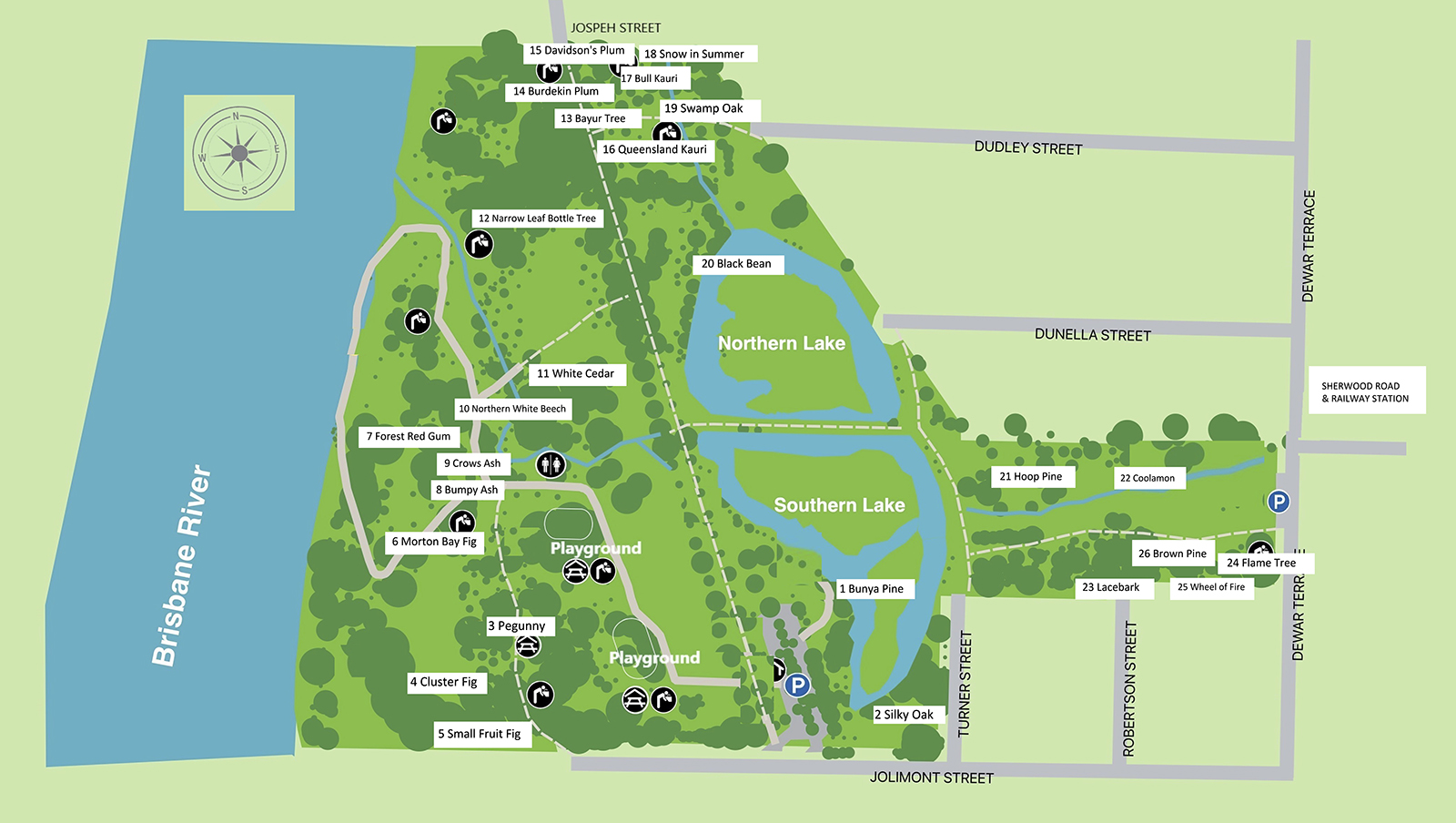![]()
Discover our Tree Trail
The heritage-listed Arboretum, with its iconic avenue of towering Queensland Kauri pines, is home to one of the nation’s most valuable collections of Australian native trees.
This collection of more than 1000 specimen trees, first established on 21 March 1925, is spread across the Arboretum’s planting communities, ranging from wet rainforest to open eucalypt forest. Today, the Assistant Curator of Brisbane Botanic Gardens manages this unique showcase of northern Australian trees.
Research by David Doley of the Queensland Division of Forestry Australia.

1. Bunya Pine
Bunya Pine Araucaria bidwillii This large conifer tree, from dry rainforests in south-east and north Queensland, was an important food source and of cultural significance for Aboriginal people. The tree is recognised by its very straight trunk, symmetrical bullet-shaped crown of many simple branches and rough to scaly dark-grey bark. Branches end in [...]
2. Silky Oak
Silky Oak Grevillea robusta This medium to large tree, from coastal forests of New South Wales and Queensland, is renowned for its long clusters of orange flowers which appear just before the new leaves in late spring. The tree is recognised by almost symmetrical branching in rapidly growing young trees. However, the branch [...]
3. White Bauhinia (Pegunny)
White Bauhinia Lysiphyllum hookeri This small tree, from monsoonal forests, coastal rainforest and open forests of north-east to central Queensland, is planted widely throughout Australia and the Pacific region as a drought-tolerant ornamental specimen. It is recognised by butterfly-shaped leaves and showy-white flowers that may appear at any time of the year. The [...]
4. Cluster Fig
Cluster Fig Ficus racemosa This is a medium to large tree growing in dry rainforest, riparian and riverside forests in coastal Australia, including north Queensland, and in South-East Asia. It is notable for being leafless in spring and for carrying dense clusters of reddish-brown pear-shaped figs on specialised branches growing from the trunk [...]
5. Small-Fruited Fig
Small-Fruited Fig Ficus microcarpa var. hillii This medium-sized to large tree, from sub-tropical coastal Queensland, is distinguished by its short grey trunk, spreading branches and dense crown of small glossy-green leaves carried on drooping twigs. The weeping fig is a variety of the Chinese Ficus microcarpa, which occurs naturally between Sri Lanka, Australia and [...]
6. Moreton Bay Fig
Moreton Bay Fig Ficus macrophylla A large evergreen tree found along Australia’s east coast from tropical Queensland to immediately south of Sydney and on Lord Howe Island. This tree is best known for its extensive buttress and aerial roots that may form a dense thicket. The bark is smooth and grey, the leaves [...]
7. Forest Red Gum
Forest Red Gum Eucalyptus tereticornis This medium to large tree, growing on river banks and open alluvial flats from eastern Victoria to Papua New Guinea, is distinguished by its steeply ascending branches and white to grey bark that is shed in irregular patches or strips. The tree usually has a straight trunk and [...]
8. Bumpy Ash
Bumpy Ash Flindersia schottiana This is a large evergreen tree of sub-tropical or dry rainforests or riverside scrubs from the mid-north coast of New South Wales to Cape York. It is distinguished by a grey-barked trunk with numerous large bumps or burls. The crown is dense and rounded, the leaves are large, up [...]
9. Crows Ash
Crows Ash Flindersia australis This tall tree grows in dry rainforests and the rainforest margins of northern New South Wales to central Queensland. The trunk is usually straight, with mottled grey bark, shed in small flakes, and the tree has a rounded crown. Leaves are up to 30 cm long with 3 to 13 [...]
10. Northern White Beech
Northern White Beech Gmelina fasciculiflora This large tree from coastal and upland rainforests of north-east Queensland carries a large dense crown. Large mauve flowers occur in clusters on branches and globular, bluish or purple fleshy fruits appear in summer. The bark is grey and scaly. The leaves, often shed in July or August, [...]
11. White Cedar
White Cedar Melia azederach This small to large tree grows in dry and coastal rainforests of northern and eastern Australia and South-East Asia. White Cedar is recognised by the furrowed brown bark, winter-deciduous large dark green fern-like leaves and abundant clusters of fragrant, pink or lilac star-shaped flowers in spring. The small yellow [...]
12. Narrow-leaved Bottle Tree
Narrow-Leaved Bottle Tree Brachychiton rupestris This eye-catching medium-sized tree grows in rocky hills and slopes in dry rainforests and brigalow scrubs of central to southern Queensland. The tree is recognised by its bulbous trunk, topped by irregular spreading branches carrying narrow, sometimes divided leaves that are shed during the dry season (spring in [...]
13. Bayur Tree
Bayur Tree Pterospermum acerifolium This large tree occurs naturally along stream banks in monsoonal regions of India and Myanmar. It is distinguished by a spreading crown and very large leaves which were commonly used as dinner plates. The wood is soft and not strong, but extremely durable and was used in domestic [...]